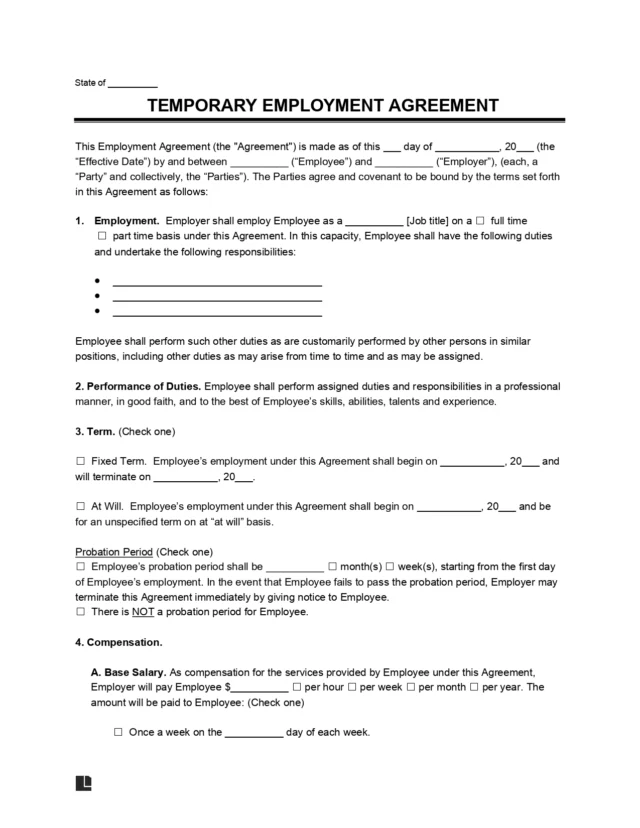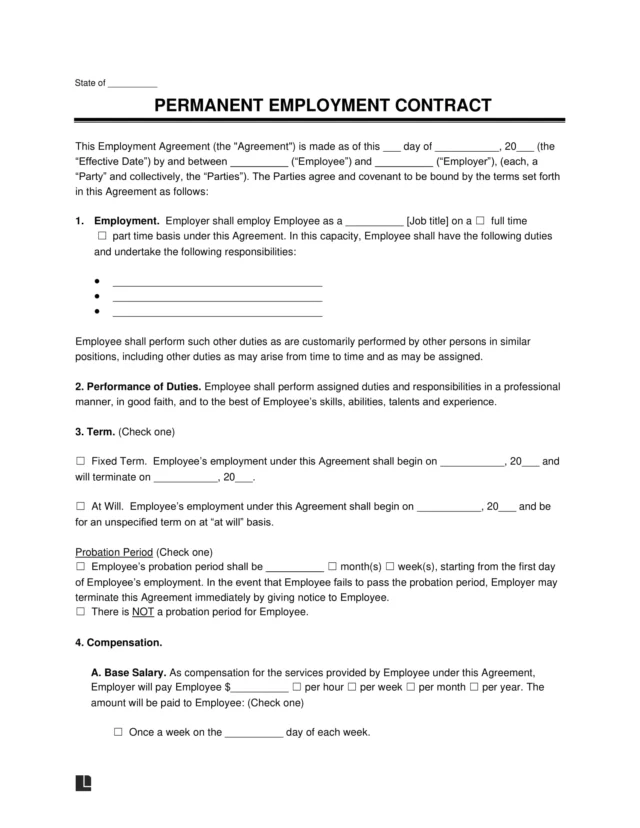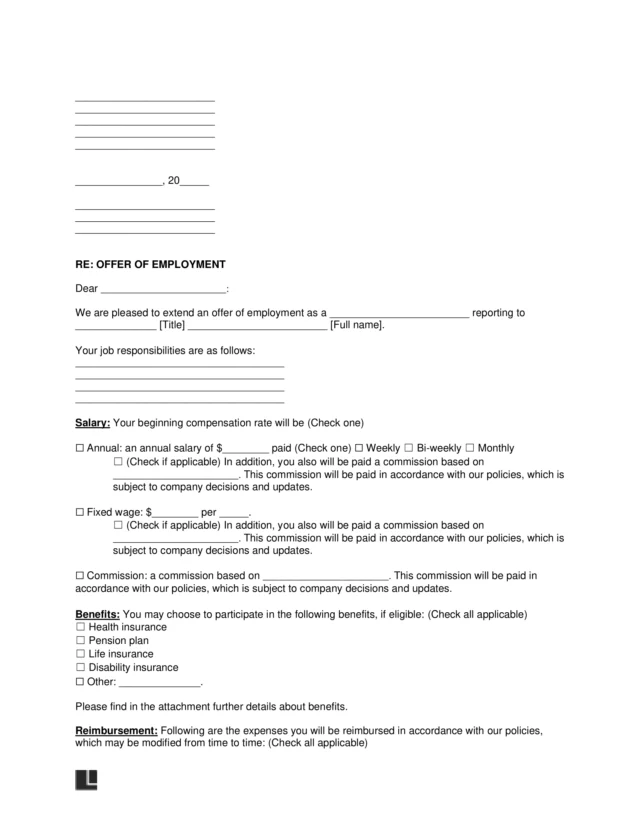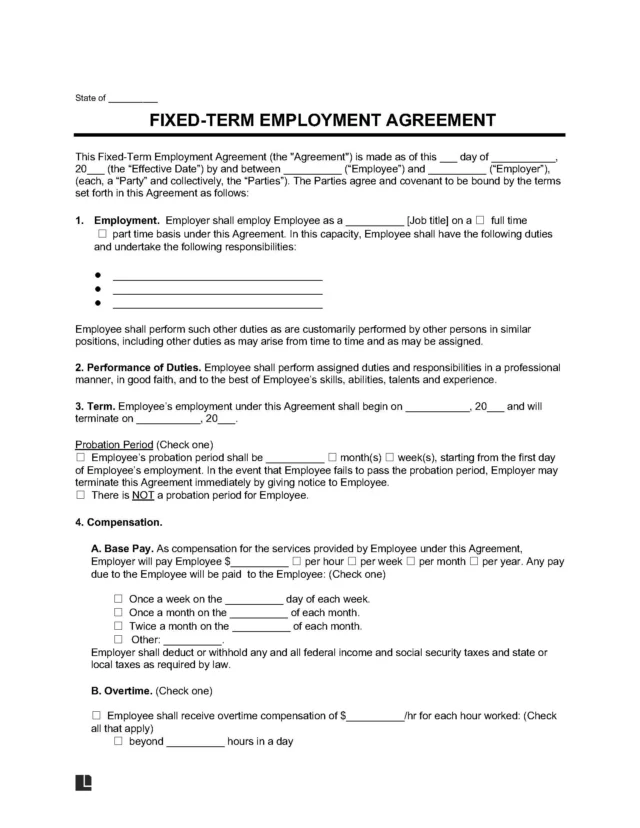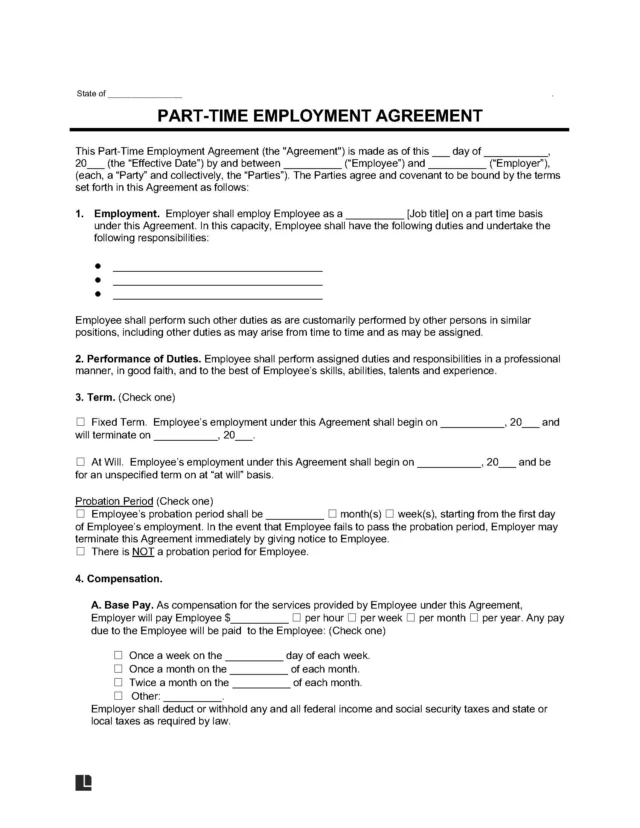What Is an Executive Employment Agreement?
An Executive Employment Agreement is a legally binding document that outlines the terms and conditions of an executive employee’s employment. This agreement typically includes the executive’s responsibilities, compensation, benefits, and termination clauses.
Employers often use templates to create these agreements. Still, at the executive level, the contract may be more of a mutually agreed list of responsibilities and benefits, with the executive having more say in their employment than a junior employee.
Executive Employment Agreement Sample
Download our executive employment agreement in PDF or Word format below:
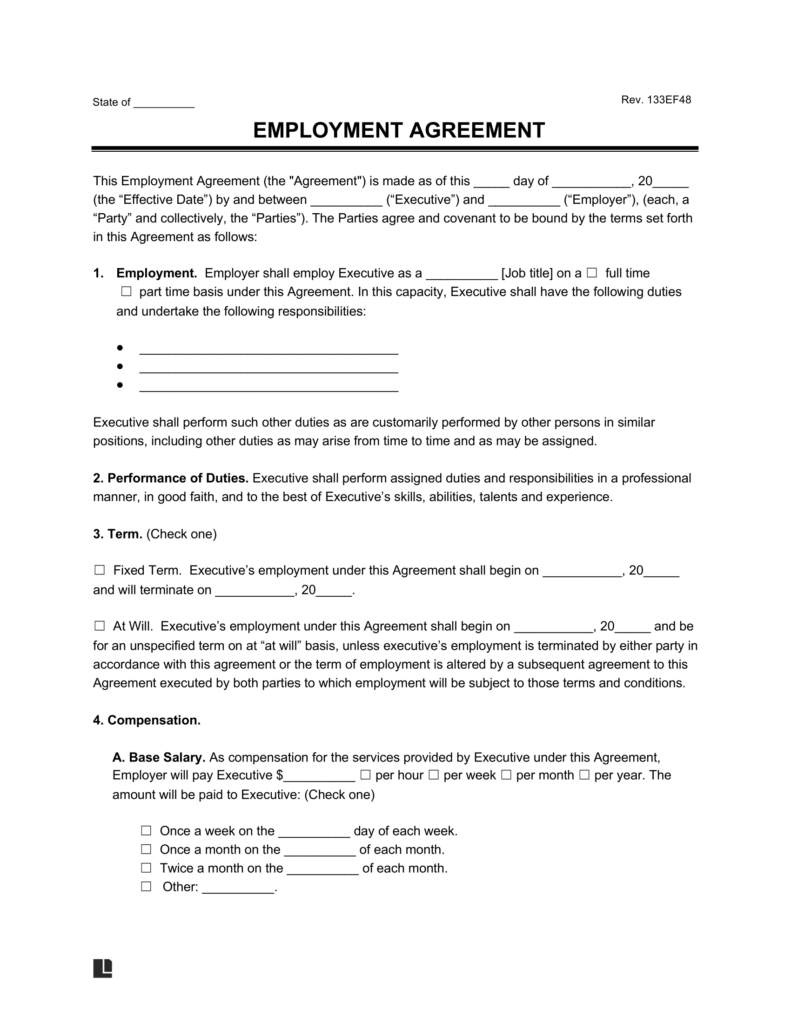
What to Include
As a minimum, include the following in your agreement:
- Employer
- Name of executive
- Position
- Start date
- Term
- Benefits
- Confidentiality clause
- Non-solicitation clause
- Non-competition clause
- Probationary period
- Termination terms
- Work-for-hire clause
- Agency provision
A business executive is typically responsible for running an organization, but the nature of the role varies. Executives are commonly chief executive officers (CEOs), other C-Level or senior executives/employees.
How to Write an Executive Employment Agreement
Detailed below is the critical information that needs to be in an executive contract. Note that this is not an exhaustive list – depending on the nature of your business and the role the executive wishes to play, additional areas may need to be set out as part of the contractual responsibilities.
1. Employee and Employer Details
The name of the employee (although an executive may not have employee status; they may be freelance or hired as an independent contractor) and the name of the employer, as well as the date the contract becomes effective.

2. List of Responsibilities or Desired Outcomes
Although employees usually have a job title and a list of responsibilities, executives often have a set of outcomes they are employed to achieve without a prescriptive list of tasks. Executives are frequently appointed based on their ability to achieve results (for example, successfully oversee a merger, improve productivity, or mastermind a change in organizational culture). How they accomplish this is often left up to them and doesn’t feature in a contractual agreement.
Unlike most other employees, executives won’t always have a set number of hours or days that they need to work. There may also be a lot of flexibility around the hours they need to be in the office. An executive’s performance is often judged on outcomes rather than hours worked.

3. Compensation (Direct Financial Remuneration)
Executive compensation might include a basic salary, dividends, and/or bonus payments.

4. Date of Employment Commencement
Duration of Contract – this may be set for a year initially (a probationary period), with a continuation dependent on favorable performance.

5. Executive Benefits (Anything Other than Financial Remuneration)
This could include anything from a company car to health insurance, relocation allowance, childcare vouchers, disability protection, maternity benefits, sick pay, vacation allowance, or other perks such as subsidized meals or a well-being allowance.
When considering executive benefits, it’s important to remember that these people are hired because they are a significant asset to your organization – they are the individuals who should be able to deliver ambitious corporate goals. There won’t be many individuals who can do what a seasoned executive can. As such, they will demand and deserve a significant portfolio of benefits. The benefits an executive will expect are frequently far more than those a more junior employee might hope for.
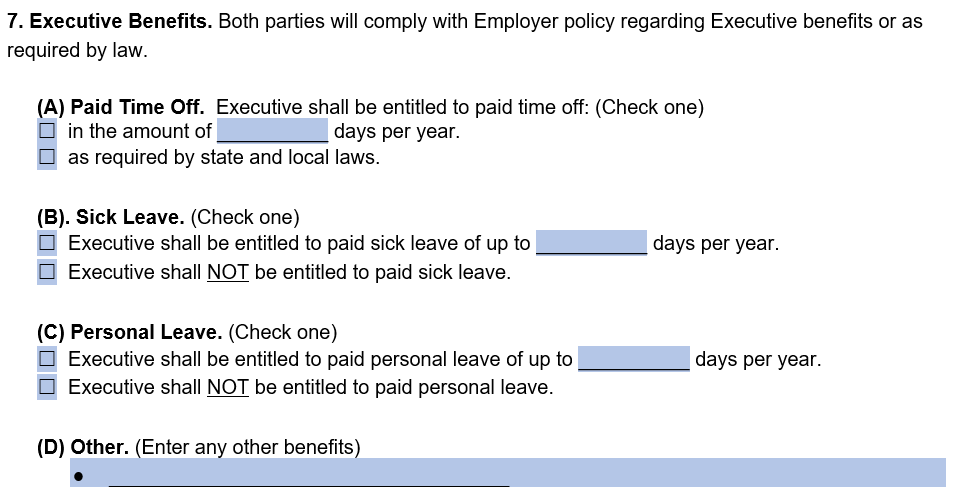
6. Legal Protections
In employer/employee contracts, legal protections tend to be put in place to protect the employer. For employer/executive contracts, the executive may also request legal protection on a specific matter, perhaps relating to an additional role they fulfill or a pecuniary interest in another company.
Executives are usually highly skilled and experienced experts in their field who have considerable worth. As such, they can dictate the terms of their employment in a way that wouldn’t be appropriate for a junior employee.
Commonly, an employer will include the following clauses:
- Non-competition – as part of the contract, the executive will agree not to work for a company that competes for your audience. This will also include a confidentiality clause relating to using information specific to your organization that could give competitors a trade advantage if it were known.
- Non-solicitation. If the executive leaves, this clause prevents them from persuading critical members of your team to join them in their next venture.
- Confidentiality – the executive will not disclose information that could damage your company or its customers.

7. Grounds for Termination
For an executive, these may relate less to objective variables (such as poor attendance or failure to complete specific tasks) than subjective variables (inability to motivate the management team or a poor fit with corporate culture).
A time-served executive is unlikely to take up an appointment unless willing to give it their best shot. Executives are usually ambitious self-starters who will move elsewhere if they feel they can’t achieve what’s needed.
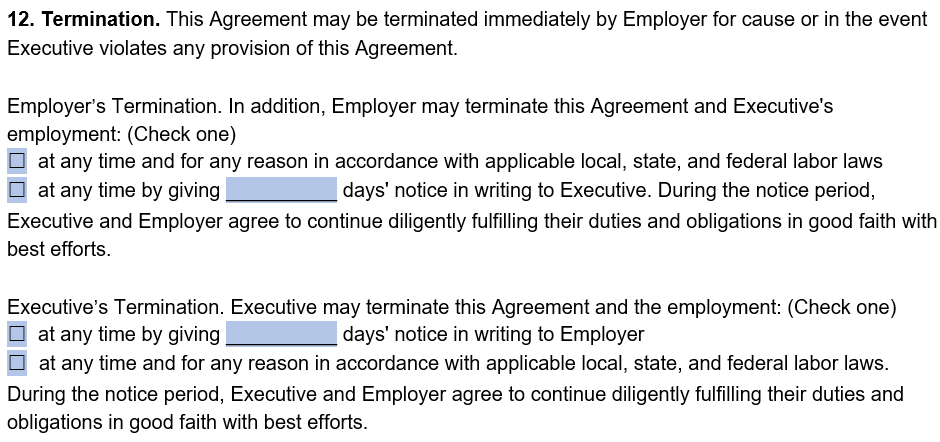
8. Signatures
Both parties must sign the agreement to make the document legally binding.
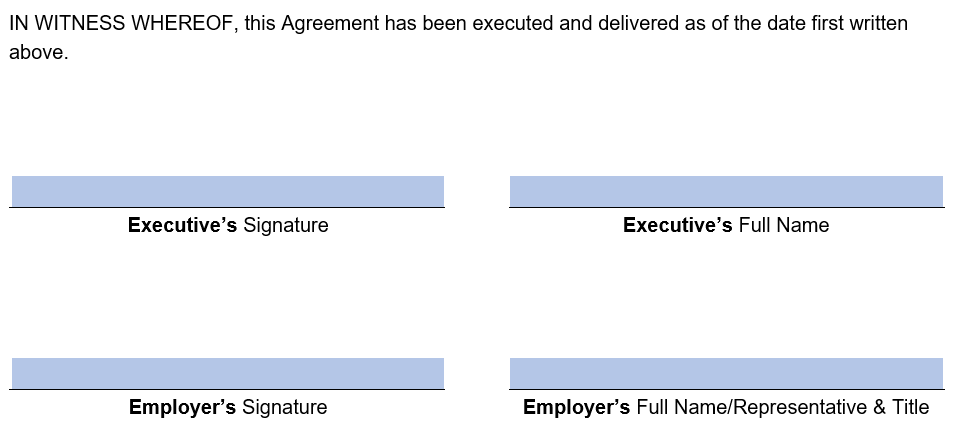
From the Executive’s Perspective
From the perspective of an executive, an executive employment contract should cover several points, often which are up for negotiation:
1. Guaranteed Minimum Terms of Employment
Executive employment typically provides a guaranteed term of employment, often a fixed-term contract with mutual early termination clauses, with and without cause. This way, the executive and the business understand the terms of the relationship if anything changes in the future.
2. Signing Bonus
A C-level or senior executive considering entering into an executive agreement could try to negotiate a signing bonus, being paid upfront. Bonuses typically include a 15-25% immediate payment of annual cash payments and sometimes a 10-30% vesting of options, stock, or other equity.
3. Benefits and Expense Reimbursement
If the executive is a new hire, relocation assistance should be considered. This should typically cover temporary living, moving expenses, losses on a home sale, etc. The agreement should also cover expense payments for the executive’s education and advancement, which can lead to direct company benefits, making the hire more valuable. Additionally, reimbursement of business travel expenses and everyday expenses should be considered.
4. Non-competes and NDAs
Non-disclosure agreements can be used by businesses to protect their and future trade secrets. However, NDAs should not affect the executive’s prior knowledge or connections. Non-compete agreements are typically used but cannot prevent the executive from leaving or strain their career growth.
5. Severance
Severance terms should be highly negotiated to cover the executive against the company’s normal right to terminate without cause and against the executive violating any non-compete clauses on termination. Duration depends on the position, but further severance terms should be considered, such as continuing health benefits and bonuses. Severance terms should also provide some cost and deterrent against the termination of an executive who has invested substantial career time in taking the position.



